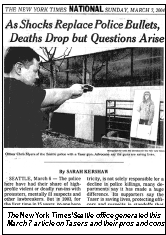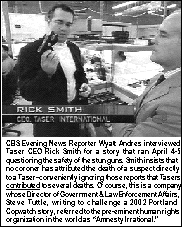TASERS CONTINUE CAUSING STATIC
Local, National Attention to Electroshock Devices Extends Debate
Nearly two years since their introduction into the Portland Police Bureau's arsenal, Tasers continue to
raise
concerns in the community and around the country over their possible misuse and, perhaps, deadly
consequences.
Local Willamette Week reporter Nick Budnick wrote several stories, including the front-page article "Is the PPB Going Taser Crazy?", beginning in the February 4 issue. Budnick allowed himself to be hit with one of the electroshock devices, experiencing 50,000 volts for only one second, not the normal cycle of five seconds, prompting him to describe the Taser as "torturous." Budnick pointed out that the Portland policy allows for Tasers to be used on people who "'display the intent to engage in violent, aggressive actions,' are suicidal, or 'display the intent to engage in physical resistance to a lawful police action'" (from Directive 1051.00). This is contrary to the reason Tasers were brought to Portland in the first place--as an alternative to deadly force. In other words, rather than training officers to use Tasers in place of a gun, the PPB is training to use them as the equivalent of pepper spray, batons, or body blows.
Budnick explains that in Phoenix, where deadly shootings apparently have been reduced dramatically, Tasers are not allowed to be used for "coercion" or "intimidation." In Portland, however, police have been using Tasers to exert their power over citizens. They are proud of the fact that out of the 447 uses of the Taser in its first 18 months, 64 times officers simply pointed the laser sight at a suspect. But is this how we want community policing to work? How does a person know it is not a real gun being pointed at them? And would it have been appropriate to point a gun at the suspect in each of these 64 cases?
In a follow-up article on February 18, Willamette Week says that at least 25 people were Tasered after they were in handcuffs, mostly with the device used as a stun gun (as opposed to firing its fish-hook barbs up to 21 feet) and in response to low-level resistance from suspects like stiffening up. There have been at least eight Taserings of people's groins in Portland, a tactic forbidden in Phoenix.
 Meanwhile, Tasers are getting national scrutiny as well. Portland Copwatch has received calls from
Delaware,
Florida, the Charleston (SC) Post and Courier and the New York Times, all doing
articles about Tasers. The
Times, in its March 7 article, raised questions about the growing number of deaths in Taser-
related incidents
(the February 11 Willamette Week puts that number at 37). The Times specifically cites the
death of
William Lomax, 26, in Las Vegas in February, where witnesses and the police say Lomax collapsed
after police
Tasered him four or five times.
Meanwhile, Tasers are getting national scrutiny as well. Portland Copwatch has received calls from
Delaware,
Florida, the Charleston (SC) Post and Courier and the New York Times, all doing
articles about Tasers. The
Times, in its March 7 article, raised questions about the growing number of deaths in Taser-
related incidents
(the February 11 Willamette Week puts that number at 37). The Times specifically cites the
death of
William Lomax, 26, in Las Vegas in February, where witnesses and the police say Lomax collapsed
after police
Tasered him four or five times.
The ACLU of Colorado released a 10-page memo on February 26, including information on 29 of the in-custody deaths from 2001-2003. They cite a 1992 report by Dr. Terence B. Allen regarding a Taser-related death in Los Angeles in which he wrote "death was an immediate and direct result of the taser.... Pre-existing heart disease, psychosis, and the use of drugs including cocaine, PCP, amphetamine and alcohol may substantially increase the risk of fatality." They note that in addition to L.A., medical examiners in Orlando, FL, and Wallen's Ridge, VA cited the use of a Taser as a contributing factor in deaths in each of those cities. The ACLU also cites a 1999 Department of Justice report that concludes Tasers may contribute to death even if they are not the immediate cause of death.
 Officers who voluntarily receive shocks, as did reporter Budnick, only receive one-half to one second
shocks,
which manufacturer Taser International admits is a "tremendous difference" from a full five-
second pulse. The
ACLU describes the result of a full blast as "immediate, overwhelming, and excruciating pain"
which maybe more
than necessary to get a suspect to cooperate with police.
Officers who voluntarily receive shocks, as did reporter Budnick, only receive one-half to one second
shocks,
which manufacturer Taser International admits is a "tremendous difference" from a full five-
second pulse. The
ACLU describes the result of a full blast as "immediate, overwhelming, and excruciating pain"
which maybe more
than necessary to get a suspect to cooperate with police.
The ACLU's memo requests that the Denver Police Department (DPD) revise its policies on Tasers to restrict use to only cases in which the use of firearms would be justified. They also request that, as in the UK, where police chiefs adopted that restrictive policy, the DPD record every use of Tasers, including the "drawing of a device...whether or not this is accompanied by a verbal warning, sparking of the device or placing of the taser sight red dot onto a subject."
The Portland Police are currently reviewing their policy on Tasers.
If you have input, contact Chief Foxworth's office at 503-823-0000. He may actually respond if your request is sent in writing to 1111 SW 2nd, Portland, OR 97204.